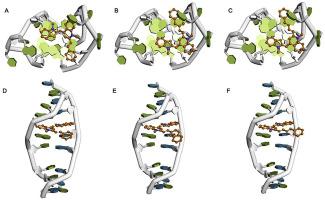Our official English website, www.x-mol.net, welcomes your feedback! (Note: you will need to create a separate account there.)
Structural modification of nonspecific thiazole orange for ligand-DNA interaction study: Understanding the ligand recognition selectivity towards G4-DNA over duplex-DNA
Journal of Luminescence ( IF 3.6 ) Pub Date : 2020-10-01 , DOI: 10.1016/j.jlumin.2020.117488 Yiwen Zhu , Jinqiang Hou , Xuan-He Huang , Dong-Xiao Zhong , Wei Long , Wenjie Liu , Yu-Jing Lu , Kun Zhang , Wing-Leung Wong
Journal of Luminescence ( IF 3.6 ) Pub Date : 2020-10-01 , DOI: 10.1016/j.jlumin.2020.117488 Yiwen Zhu , Jinqiang Hou , Xuan-He Huang , Dong-Xiao Zhong , Wei Long , Wenjie Liu , Yu-Jing Lu , Kun Zhang , Wing-Leung Wong

|
Abstract The study of ligand interactions with nucleic acid structures such as G-quadruplexes versus double-stranded DNA is important because these interactions are fundamental for many intracellular processes. In the investigation of ligand-DNA binding process, achieving high fluorescent signal discrimination with strong binding affinity is challenging. To develop binding ligands with excellent recognition ability towards G4-DNA over duplex-DNA, the design of appropriate molecular scaffolds that are able to match with the G4-DNA binding pocket (G-quartet) is crucial. In the present study, the new fluorescent DNA binding ligands were designed and synthesized through the integration of a small and conjugated substituent group at the 2-position of the 1-methylquinolinium moiety of the nonspecific thiazole orange scaffold. The ligands were investigated in fluorescence binding assays and showed different interaction properties and significant fluorescent recognition selectivity towards G4-DNA over duplex-DNA in vitro. Molecular docking study of the ligands in complex with telo21 G4-DNA and ds26 duplex DNA also revealed different binding modes. In addition, the cytotoxicity of the fluorescent DNA binding ligands was evaluated in MTT assays against two selected cancer cell lines (human prostate cancer cell (PC3) and human hepatoma cell (hepG2)). The IC50 was found in the range of 6.3–12.5 μM, indicating a relatively high cytotoxicity of the ligands towards the cancer cells examined.
中文翻译:

用于配体-DNA 相互作用研究的非特异性噻唑橙的结构修饰:了解对 G4-DNA 的配体识别选择性优于双链 DNA
摘要 研究配体与核酸结构(如 G-四链体与双链 DNA)的相互作用很重要,因为这些相互作用是许多细胞内过程的基础。在配体-DNA 结合过程的研究中,实现具有强结合亲和力的高荧光信号识别具有挑战性。为了开发对 G4-DNA 具有优于双链 DNA 的优异识别能力的结合配体,设计能够与 G4-DNA 结合口袋(G-四重体)匹配的适当分子支架至关重要。在本研究中,通过在非特异性噻唑橙支架的 1-甲基喹啉鎓部分的 2 位整合一个小的共轭取代基团,设计和合成了新的荧光 DNA 结合配体。在荧光结合测定中研究了配体,并在体外对 G4-DNA 显示出不同的相互作用特性和显着的荧光识别选择性。与 telo21 G4-DNA 和 ds26 双链 DNA 复合的配体的分子对接研究也揭示了不同的结合模式。此外,在 MTT 测定中针对两种选定的癌细胞系(人前列腺癌细胞 (PC3) 和人肝癌细胞 (hepG2))评估了荧光 DNA 结合配体的细胞毒性。IC50 的范围为 6.3-12.5 μM,表明配体对所检查的癌细胞具有相对较高的细胞毒性。与 telo21 G4-DNA 和 ds26 双链 DNA 复合的配体的分子对接研究也揭示了不同的结合模式。此外,在 MTT 测定中针对两种选定的癌细胞系(人前列腺癌细胞 (PC3) 和人肝癌细胞 (hepG2))评估了荧光 DNA 结合配体的细胞毒性。IC50 的范围为 6.3-12.5 μM,表明配体对所检查的癌细胞具有相对较高的细胞毒性。与 telo21 G4-DNA 和 ds26 双链 DNA 复合的配体的分子对接研究也揭示了不同的结合模式。此外,在 MTT 测定中针对两种选定的癌细胞系(人前列腺癌细胞 (PC3) 和人肝癌细胞 (hepG2))评估了荧光 DNA 结合配体的细胞毒性。IC50 的范围为 6.3-12.5 μM,表明配体对所检查的癌细胞具有相对较高的细胞毒性。
更新日期:2020-10-01
中文翻译:

用于配体-DNA 相互作用研究的非特异性噻唑橙的结构修饰:了解对 G4-DNA 的配体识别选择性优于双链 DNA
摘要 研究配体与核酸结构(如 G-四链体与双链 DNA)的相互作用很重要,因为这些相互作用是许多细胞内过程的基础。在配体-DNA 结合过程的研究中,实现具有强结合亲和力的高荧光信号识别具有挑战性。为了开发对 G4-DNA 具有优于双链 DNA 的优异识别能力的结合配体,设计能够与 G4-DNA 结合口袋(G-四重体)匹配的适当分子支架至关重要。在本研究中,通过在非特异性噻唑橙支架的 1-甲基喹啉鎓部分的 2 位整合一个小的共轭取代基团,设计和合成了新的荧光 DNA 结合配体。在荧光结合测定中研究了配体,并在体外对 G4-DNA 显示出不同的相互作用特性和显着的荧光识别选择性。与 telo21 G4-DNA 和 ds26 双链 DNA 复合的配体的分子对接研究也揭示了不同的结合模式。此外,在 MTT 测定中针对两种选定的癌细胞系(人前列腺癌细胞 (PC3) 和人肝癌细胞 (hepG2))评估了荧光 DNA 结合配体的细胞毒性。IC50 的范围为 6.3-12.5 μM,表明配体对所检查的癌细胞具有相对较高的细胞毒性。与 telo21 G4-DNA 和 ds26 双链 DNA 复合的配体的分子对接研究也揭示了不同的结合模式。此外,在 MTT 测定中针对两种选定的癌细胞系(人前列腺癌细胞 (PC3) 和人肝癌细胞 (hepG2))评估了荧光 DNA 结合配体的细胞毒性。IC50 的范围为 6.3-12.5 μM,表明配体对所检查的癌细胞具有相对较高的细胞毒性。与 telo21 G4-DNA 和 ds26 双链 DNA 复合的配体的分子对接研究也揭示了不同的结合模式。此外,在 MTT 测定中针对两种选定的癌细胞系(人前列腺癌细胞 (PC3) 和人肝癌细胞 (hepG2))评估了荧光 DNA 结合配体的细胞毒性。IC50 的范围为 6.3-12.5 μM,表明配体对所检查的癌细胞具有相对较高的细胞毒性。



























 京公网安备 11010802027423号
京公网安备 11010802027423号